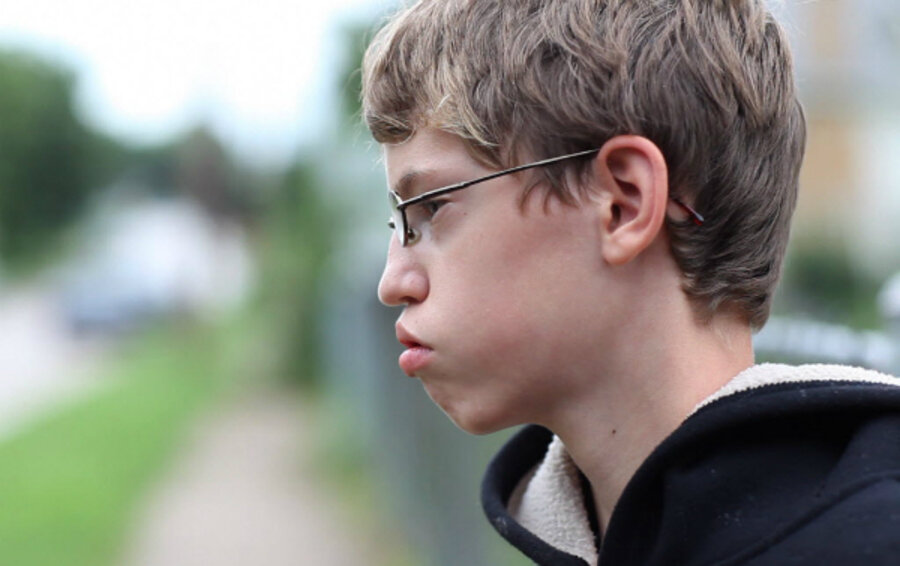How to end bullying? Talk about it. A lot
Loading...
| Janesville, Wis.
The kids in Amanda Werner's fifth-grade class were role playing.
The scene: A girl on the bus was calling another girl names.
"I would tell the driver. Or I would go up to her and tell her she shouldn't say mean things to people," Payton Kahl said.
"Would you confront her?" asked student services specialist Ryan Stengl, who was leading the discussion.
"I would," Payton said.
"I would tell her to stop being mean," agreed Caleb Nelson.
Stengl wanted to make a point about confronting the bully. "If you feel safe doing that, that's probably the biggest difference you could make," Stengl told the students.
Stengl talked to the kids about bullying when they were fourth-graders. He was back to give them a refresher. All students at Adams Elementary get lessons and reminders on a regular basis. It's part of the school's overall discipline program, The Janesville Gazette reported.
Schools these days are working to stamp out bullying before it starts, or at least limit it as much as possible. They start early and repeat the message often, said Adams Principal Sally Parks and Stengl, who sat for a separate interview.
The local effort reflects a push by the federal government, which started an interagency website, stopbullying.gov, Parks noted. An attitude of an earlier generation was that bullying happens, kids will be kids, and there's not much that can be done to prevent it, Parks said.
Now, educators intervene early, hoping students will be less likely to be bullies or victims of bullies later. Middle school, as district statistics suggest, is the worst time for bullying. Werner's fifth-graders will be in middle school next September.
"We're really teaching social skills, and the best time to learn that is early on," Stengl said.
"I don't think anyone here is a bully," Werner told her students. "But I've talked to you guys about your choices."
Indeed, after numerous visits to the class, The Gazette has seen little evidence of meanness and never an outright bullying incident.
Werner told the kids she wants them to recognize their roles when bullying occurs — do they encourage the bully by joining in or even by not getting involved, or do they do something?
"That's a tricky part," she said. "It's tricky even for adults."
Kids are taught that telling an adult about bullying is not the negative "tattling" of a previous generation. "We really need the kids on board, so they're reporting and talking to us," Parks said.
Students are encouraged to report incidents even if they aren't sure that what they saw was a problem. That message — don't be a passive bystander; do something — was not what children were told not so long ago, Parks said. The message is that if you do nothing, you're a part of the problem.
Bullying-prevention messages are reinforced through the year — signs on the walls, a Bullying Prevention Week, and class discussions. Even reading class can help, with a large selection of books about friends, Parks said.
Stengl reviewed with the class what bullying is and isn't.
A dispute or a fight are not necessarily bullying, he reminded them, and he asked the kids to recall the questions that distinguish bullying from something else.
"Is it one-sided or two?" Stella Pearson said.
"Is it happening repeatedly?" Deonica Pauls said.
They couldn't recall the last question.
"You can feel it in your gut," Stengl told them. "Is this unfair, what's happening? Is it unjust?"
What can a fifth-grader do when bullying happens? Stengl encouraged them to stand up for themselves or for others. "If you are a bystander and you don't speak up, what are you doing?"
Being passive only makes the problem worse, the kids heard in a short video.
Stengl also mentioned something these kids' parents didn't deal with at their age: cyberbullying. That aspect has gotten lots of attention of late, with the introduction of bullying with a cellphone text message or social media postings, which make it all the more hurtful because they are broadcast to a larger audience and don't go away.
That's an aspect that is bound to loom larger in these students' lives in middle and high school.
Bullying also can be about excluding someone, Werner told the kids. Has anyone ever felt left out? Ever witnessed bullying? Ever been bullied? As Werner asked the questions, most hands went up, although there were fewer for the last question.
Developing empathy — the capacity to understand what another student is feeling — is part of the program as well. The key is self-confidence, officials believe.
"Really confident kids don't have many issues with getting picked on," Stengl said. "Things happen, but it's our hope kids will be so confident in their own skin that it just won't bother them," he added.
The bully is not ignored in all of this. The old procedure was one of zero tolerance, Parks said. Now, Parks' task is to find out what's the source of the bully's actions and to deal with what's going on in the child's life. Parks will work with troubled students, getting families involved, and setting goals that lead the offender back to the right track.
By nipping a dispute in the bud, a student who shows tendencies could be led in a positive direction and never become a full-fledged bully, Parks suggested.
Students are sometimes brought into a "restorative circle" in which the bully and victim discuss what happened and try to understand each other's behavior, Stengl said.
Follow-up is key, Stengl said. Students involved in past incidents are asked regularly how they're doing.
Staff members are trained to be on the lookout for tensions developing between students, and they warn each other if they suspect a flare-up is imminent.
"We have a great staff in terms of caring about kids and being in tune to changes in kids," Parks said.







